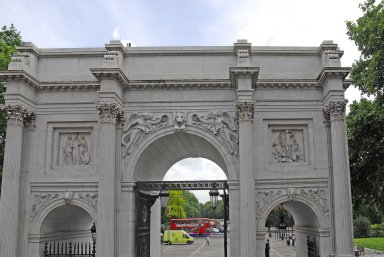Detail View: Archivision Base to Module 9: Hyde Park and Kensington Gardens, London

|
Preferred Title:
|
Hyde Park and Kensington Gardens, London
|
|
Alternate Title:
|
Hyde Park
|
|
Image View:
|
Marble Arch (1827-1833 by John Nash), at the northeast corner of Hyde Park, opposite Speakers' Corner
|
|
Creator:
|
Charles Bridgeman (British landscape architect, died 1738)
|
|
Location:
|
site: London, England, United Kingdom
|
|
Location Note:
|
South boundry, Kensington Road, north boundry, Bayswater Road
|
|
GPS:
|
+51.508611-0.163611
|
|
Date:
|
begun 1536 (creation)
|
|
Cultural Context:
|
British
|
|
Style Period:
|
Eighteenth century
|
|
Work Type 1:
|
parks (recreation areas)
|
|
Work Type 2:
|
garden
|
|
Classification:
|
landscape architecture
|
|
Material:
|
stone; brick; paving material; plant material
|
|
Technique:
|
construction (assembling); gardening
|
|
Measurements:
|
350 ac (area, Hyde Park); 270 ac (area,Kensington Gardens)
|
|
Description:
|
Largest park area in central London and two of the Royal Parks of London. The park is divided in two by the Serpentine; the western half is Kensington Gardens. The two parks are contiguous; although often still assumed to be part of Hyde Park, Kensington Gardens has been technically separate since 1728, when Queen Caroline made a division between the two. The combined area of 630 acres is larger than the Principality of Monaco (480 acres), though smaller than New York City's Central Park (840 acres). The park was the site of the Great Exhibition of 1851, for which the Crystal Palace was designed by Joseph Paxton. The park started as a royal deer park under Henry VIII in 1536. In 1689 William III laid out a drive on the south side that still exists, known as Rotten Row. The first coherent landscaping was undertaken by Charles Bridgeman for Queen Caroline. It was completed in 1733; the Serpentine (1731) was formed by damming the little Westbourne river. The Serpentine is divided from the Long Water by a bridge designed by George Rennie (1826). (Source: Wikipedia; http://en.wikipedia.org/wiki/Main_Page)
|
|
Image Description:
|
It now stands on a large traffic island at the junction of Oxford Street, Park Lane, and Edgware Road, almost directly opposite Speakers' Corner in Hyde Park. Until 1851 it stood in front of Buckingham Palace.
|
|
Collection:
|
Archivision Addition Module Seven
|
|
Identifier:
|
1A2-E-L-HP-A8
|
|
Rights:
|
© Scott Gilchrist, Archivision, Inc.
|